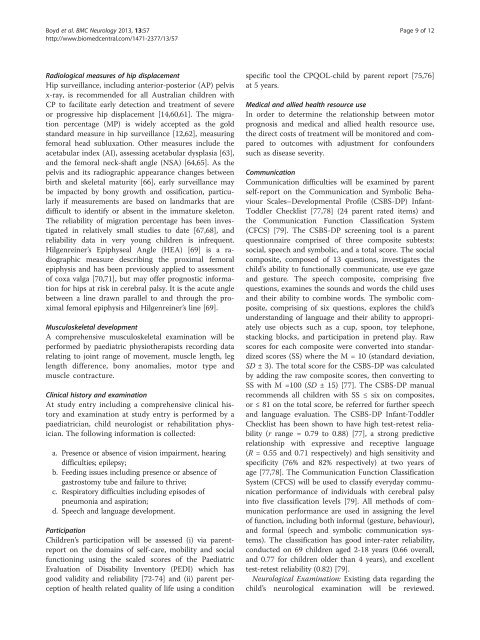Australian Cerebral Palsy Child Study: protocol of ... - BioMed Central
Australian Cerebral Palsy Child Study: protocol of ... - BioMed Central
Australian Cerebral Palsy Child Study: protocol of ... - BioMed Central
Create successful ePaper yourself
Turn your PDF publications into a flip-book with our unique Google optimized e-Paper software.
Boyd et al. BMC Neurology 2013, 13:57 Page 9 <strong>of</strong> 12<br />
http://www.biomedcentral.com/1471-2377/13/57<br />
Radiological measures <strong>of</strong> hip displacement<br />
Hip surveillance, including anterior-posterior (AP) pelvis<br />
x-ray, is recommended for all <strong>Australian</strong> children with<br />
CP to facilitate early detection and treatment <strong>of</strong> severe<br />
or progressive hip displacement [14,60,61]. The migration<br />
percentage (MP) is widely accepted as the gold<br />
standard measure in hip surveillance [12,62], measuring<br />
femoral head subluxation. Other measures include the<br />
acetabular index (AI), assessing acetabular dysplasia [63],<br />
and the femoral neck-shaft angle (NSA) [64,65]. As the<br />
pelvis and its radiographic appearance changes between<br />
birth and skeletal maturity [66], early surveillance may<br />
be impacted by bony growth and ossification, particularly<br />
if measurements are based on landmarks that are<br />
difficult to identify or absent in the immature skeleton.<br />
The reliability <strong>of</strong> migration percentage has been investigated<br />
in relatively small studies to date [67,68], and<br />
reliability data in very young children is infrequent.<br />
Hilgenreiner’s Epiphyseal Angle (HEA) [69] is a radiographic<br />
measure describing the proximal femoral<br />
epiphysis and has been previously applied to assessment<br />
<strong>of</strong> coxa valga [70,71], but may <strong>of</strong>fer prognostic information<br />
for hips at risk in cerebral palsy. It is the acute angle<br />
between a line drawn parallel to and through the proximal<br />
femoral epiphysis and Hilgenreiner’s line [69].<br />
Musculoskeletal development<br />
A comprehensive musculoskeletal examination will be<br />
performed by paediatric physiotherapists recording data<br />
relating to joint range <strong>of</strong> movement, muscle length, leg<br />
length difference, bony anomalies, motor type and<br />
muscle contracture.<br />
Clinical history and examination<br />
At study entry including a comprehensive clinical history<br />
and examination at study entry is performed by a<br />
paediatrician, child neurologist or rehabilitation physician.<br />
The following information is collected:<br />
a. Presence or absence <strong>of</strong> vision impairment, hearing<br />
difficulties; epilepsy;<br />
b. Feeding issues including presence or absence <strong>of</strong><br />
gastrostomy tube and failure to thrive;<br />
c. Respiratory difficulties including episodes <strong>of</strong><br />
pneumonia and aspiration;<br />
d. Speech and language development.<br />
Participation<br />
<strong>Child</strong>ren’s participation will be assessed (i) via parentreport<br />
on the domains <strong>of</strong> self-care, mobility and social<br />
functioning using the scaled scores <strong>of</strong> the Paediatric<br />
Evaluation <strong>of</strong> Disability Inventory (PEDI) which has<br />
good validity and reliability [72-74] and (ii) parent perception<br />
<strong>of</strong> health related quality <strong>of</strong> life using a condition<br />
specific tool the CPQOL-child by parent report [75,76]<br />
at 5 years.<br />
Medical and allied health resource use<br />
In order to determine the relationship between motor<br />
prognosis and medical and allied health resource use,<br />
the direct costs <strong>of</strong> treatment will be monitored and compared<br />
to outcomes with adjustment for confounders<br />
such as disease severity.<br />
Communication<br />
Communication difficulties will be examined by parent<br />
self-report on the Communication and Symbolic Behaviour<br />
Scales–Developmental Pr<strong>of</strong>ile (CSBS-DP) Infant-<br />
Toddler Checklist [77,78] (24 parent rated items) and<br />
the Communication Function Classification System<br />
(CFCS) [79]. The CSBS-DP screening tool is a parent<br />
questionnaire comprised <strong>of</strong> three composite subtests:<br />
social, speech and symbolic, and a total score. The social<br />
composite, composed <strong>of</strong> 13 questions, investigates the<br />
child’s ability to functionally communicate, use eye gaze<br />
and gesture. The speech composite, comprising five<br />
questions, examines the sounds and words the child uses<br />
and their ability to combine words. The symbolic composite,<br />
comprising <strong>of</strong> six questions, explores the child’s<br />
understanding <strong>of</strong> language and their ability to appropriately<br />
use objects such as a cup, spoon, toy telephone,<br />
stacking blocks, and participation in pretend play. Raw<br />
scores for each composite were converted into standardized<br />
scores (SS) where the M = 10 (standard deviation,<br />
SD ± 3). The total score for the CSBS-DP was calculated<br />
by adding the raw composite scores, then converting to<br />
SS with M =100 (SD ± 15) [77]. The CSBS-DP manual<br />
recommends all children with SS ≤ six on composites,<br />
or ≤ 81 on the total score, be referred for further speech<br />
and language evaluation. The CSBS-DP Infant-Toddler<br />
Checklist has been shown to have high test-retest reliability<br />
(r range = 0.79 to 0.88) [77], a strong predictive<br />
relationship with expressive and receptive language<br />
(R = 0.55 and 0.71 respectively) and high sensitivity and<br />
specificity (76% and 82% respectively) at two years <strong>of</strong><br />
age [77,78]. The Communication Function Classification<br />
System (CFCS) will be used to classify everyday communication<br />
performance <strong>of</strong> individuals with cerebral palsy<br />
into five classification levels [79]. All methods <strong>of</strong> communication<br />
performance are used in assigning the level<br />
<strong>of</strong> function, including both informal (gesture, behaviour),<br />
and formal (speech and symbolic communication systems).<br />
The classification has good inter-rater reliability,<br />
conducted on 69 children aged 2-18 years (0.66 overall,<br />
and 0.77 for children older than 4 years), and excellent<br />
test-retest reliability (0.82) [79].<br />
Neurological Examination: Existing data regarding the<br />
child’s neurological examination will be reviewed.
















